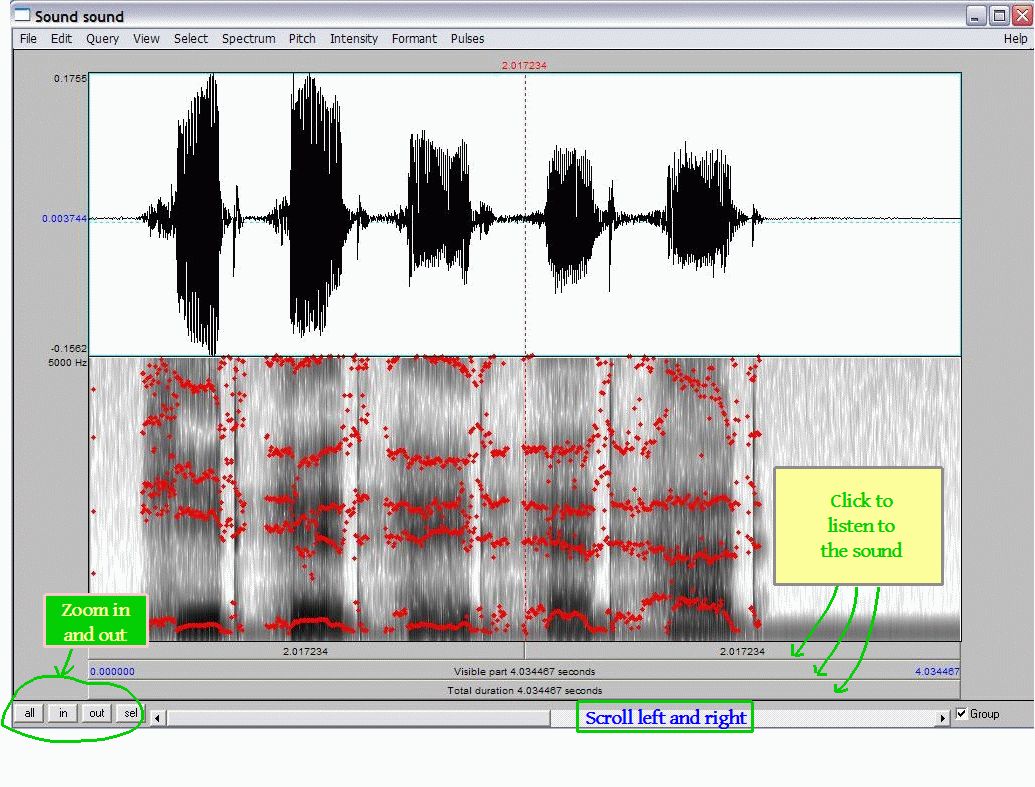

- #Praat voice analysis scripts how to
- #Praat voice analysis scripts manual
- #Praat voice analysis scripts software
- #Praat voice analysis scripts free
- #Praat voice analysis scripts windows
The algorithm and validation can be found here:ĭe Jong, N.H., Pacilly, J., & Heeren, W. This version includes an option to count filled pauses (uhm's). Note that the new and slightly better version of this script (v3) can be found here. Behavior research methods, 41 (2), 385 - 390. The aim of the Speech Corpus Toolkit for Praat (SpeCT) is to provide an organized inventory of well-documented Praat scripts that can be easily downloaded, modified and used in order to perform small tasks during the various stages of building, organizing, annotating, analysing, searching and exporting data from a speech corpus. Praat script to detect syllable nuclei and measure speech rate automatically. In Behavior Research Methods, an explanation of how the script works and a validation can be found:ĭe Jong, N.H.
#Praat voice analysis scripts free
As Praat is a free program and this script adapts to other open-source information, we hope this script will be helpful for both clinic and research. This script was written for the purpose of measuring speech rate in a large-scale study carried out at the University of Amsterdam: " What is Speaking Proficiency ". Below we have made available our Praat scripts to calculate CPP with and without voice detection. It is no longer necessary to use the tutorial to calculate these measures, as this information is printed in an info-screen. In the sound window, click View and Show analyses. Along with the pausing information, this script will automatically calculate measures such as speech rate (number of syllables / total time) as well as articulation rate (number of syllables / speaking time). This tutorial will use Praat for the acoustic analysis software. With the correct thresholds, this means the script will not only count syllables, but count and measure silent pauses as well. Additionally, this version also uses pausing information. Here you find a new version (updated september 2010), that uses a slightly different method to calculate the threshold (in line with the " To TextGrid (silences) " function that exists in PRAAT. If you use the script, please acknowledge this by citing the 2009 paper in Behavior Research Methods.
#Praat voice analysis scripts how to
Under tutorial, you can find a step-by-step explanation of how to use the script.
#Praat voice analysis scripts windows
Note that the current script runs under PRAAT in Windows only. You can copy and paste the script into a PRAAT script editor. Here you find the original praat-script written by Nivja de Jong and Ton Wempe to detect syllable nuclei. On this page you find an example of how the script works. The script subsequently discards peaks that are not voiced. Peaks in intensity (dB) that are preceded and followed by dips in intensity are considered as potential syllable nuclei. Below you will find a script that automatically detects syllable nuclei in order to measure speech rate without the need of a transcription.
#Praat voice analysis scripts software
Fall Voice Conference, University of California San Francisco.PRAAT is software for the analysis of speech ( ). Remote Voice Testing: A comparison of cepstral analysis between two remote modalities versus in-person recording. Journal of Speech, Language, and Hearing Research, 63 (12), 3991-3999. Evaluation of acoustic analyses of voice in nonoptomized conditions. Woerd, B., Wu, M., Vijay, P., Doyle, P.C., & Fung, K. Acoustic voice quality index as a potential tool for voice screening. M., Ikävalko, T., Rantala, L., Geneid, A., Holmqvist-Jämsén, S. A variety of analyses is available for (speech) signals, including pitch, intensity, formants and spectrograms, spectral balance, etc. European Archives of Oto-Rhino-Laryngology, 271 (6), 1609-1619.įaham, M., Laukkanen, A. The value of the Acoustic Voice Quality Index as a measure of dysphonia severity in subjects speaking different languages. The following paragraphs explain how you can obtain the Praat program, and how you can use this. Examples and screen shots are from the Windows edition of Praat. It also assumes modest computer experience (if you find something too explicit, just skip and read on).

#Praat voice analysis scripts manual
Maryn, Y., De Bodt, M., Barsties, B., & Roy, N. This manual for Praat is intended for beginners in speech analysis and synthesis. Objective dysphonia measures in the program Praat: smoothed cepstral peak prominence and acoustic voice quality index. The Praat programme is a tool for phonetic speech analysis developed by Paul Boersma and David Weenink in the Institute of Phonetic Sciences of the University of Amsterdam. Diagnostic accuracy of dysphonia classification of DSI and AVQI. The script goes through specified folders for sound files and TextGrids. Latoszek, B., Ulozaitė‐Stanienė, N., Petrauskas, T., Uloza, V., & Maryn, Y. This is a basic script for vowel formant analysis. The influence of gender and age on the acoustic voice quality index and dysphonia severity index: a normative study. V., Ulozaitė-Stanienė, N., Maryn, Y., Petrauskas, T., & Uloza, V.


 0 kommentar(er)
0 kommentar(er)
